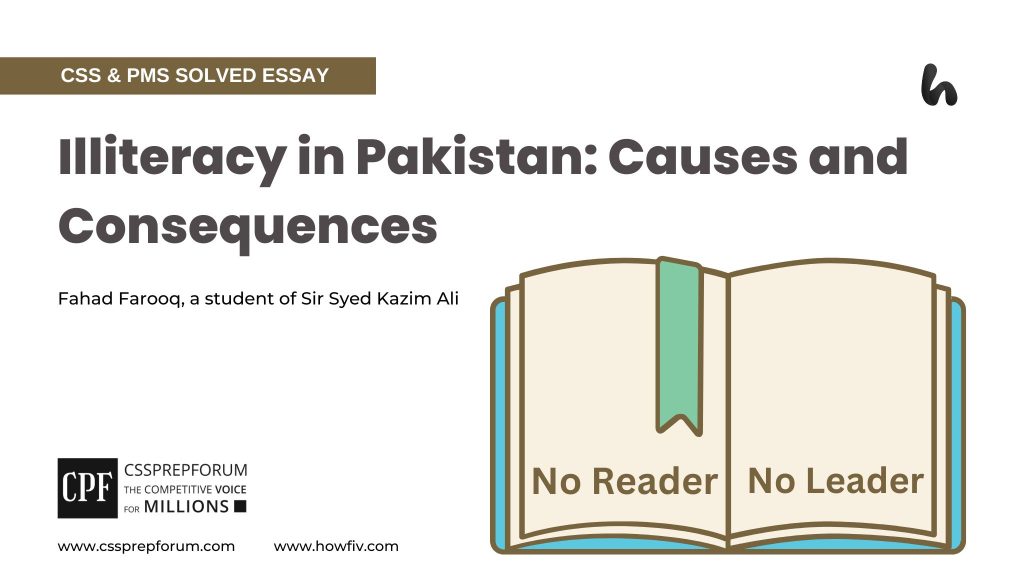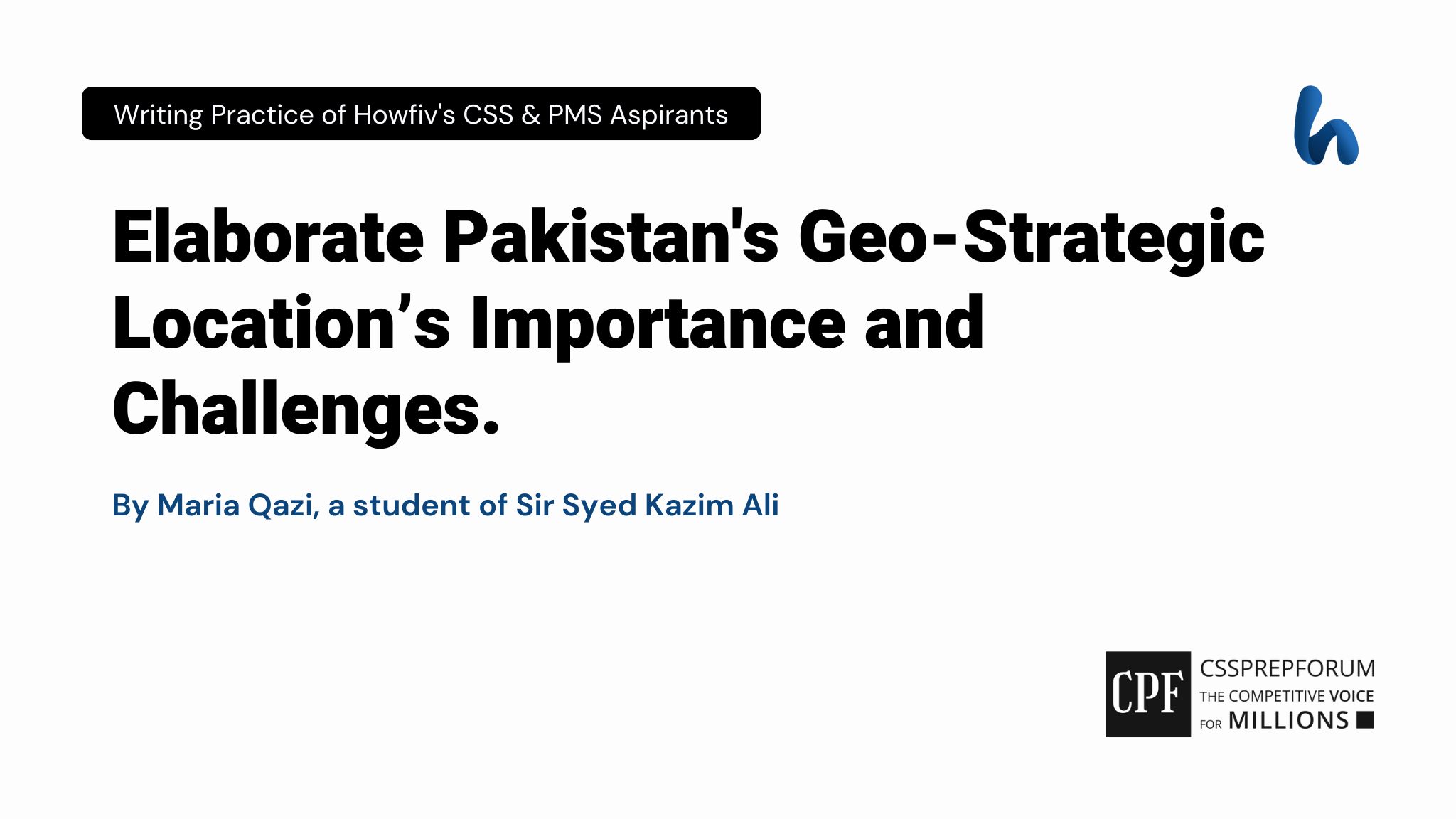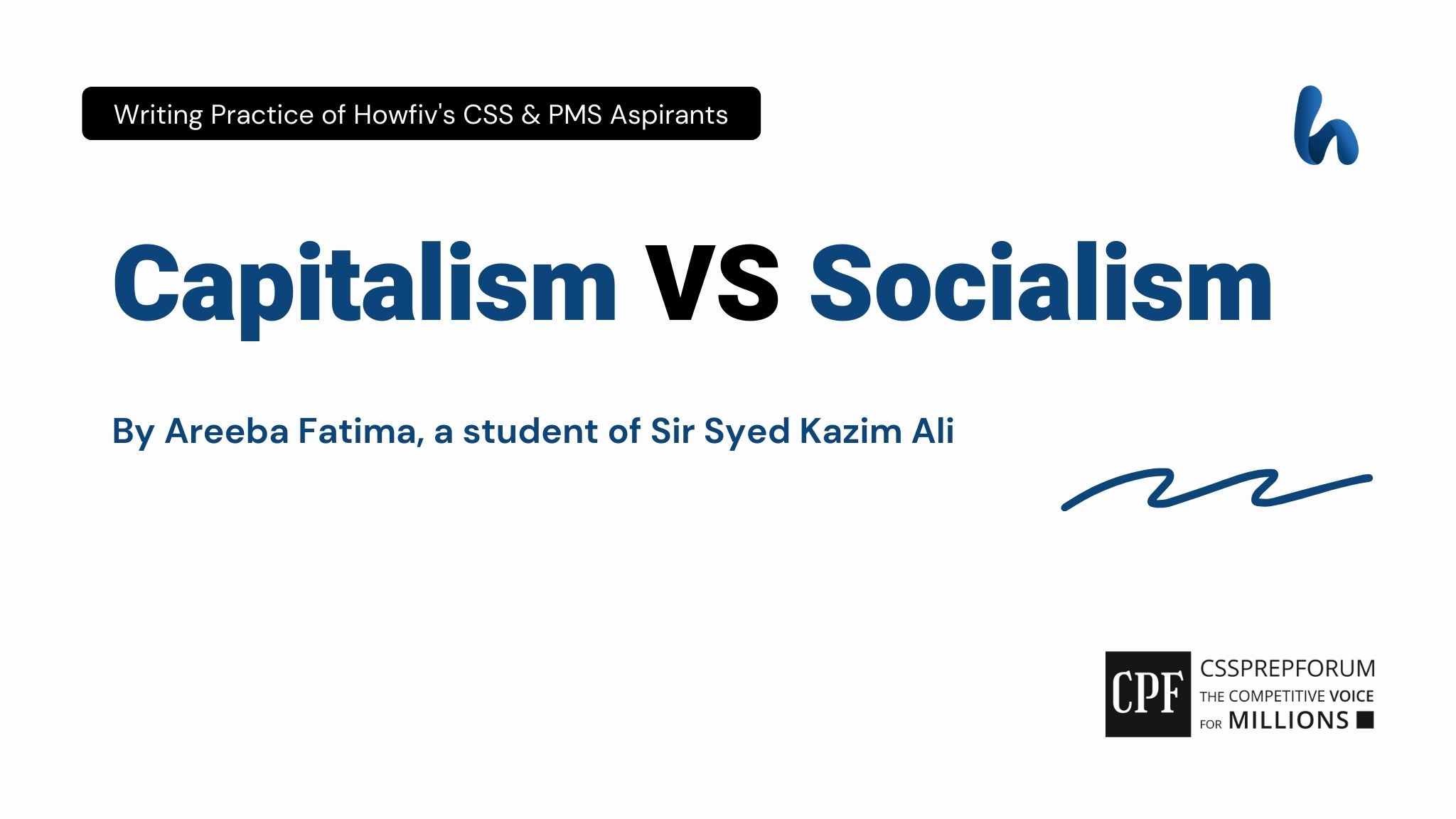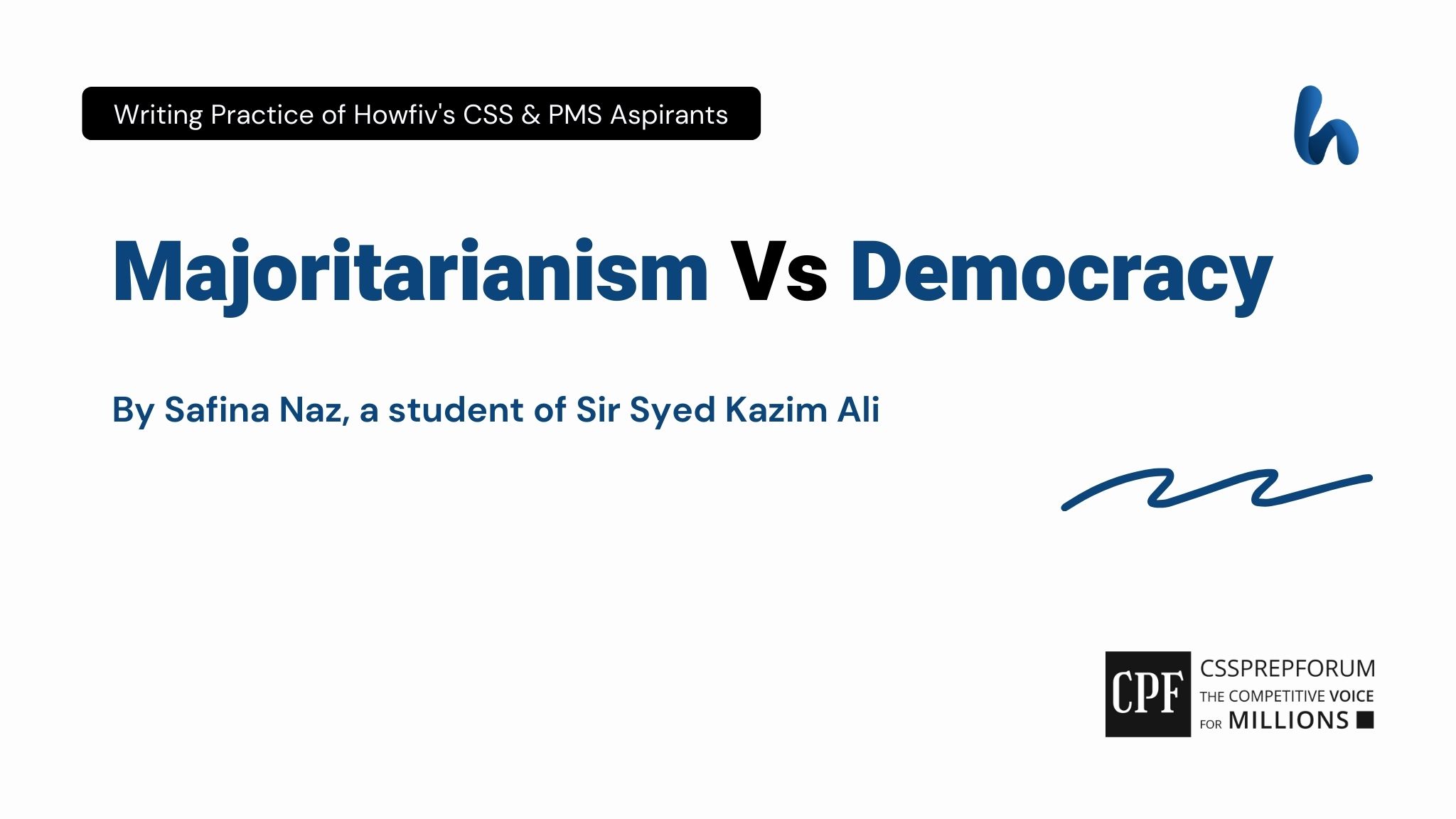CSS & PMS Solved Essays | Illiteracy in Pakistan: Causes and Consequences
Fahad Farooq, a Sir Syed Kazim Ali student, has attempted the CSS & PMS essay “Illiteracy in Pakistan: Causes and Consequences” on the given pattern, which Sir Syed Kazim Ali teaches his students. Sir Syed Kazim Ali has been Pakistan’s top English writing and CSS, PMS essay and precis coach with the highest success rate of his students. The essay is uploaded to help other competitive aspirants learn and practice essay writing techniques and patterns to qualify for the essay paper.

Outline
1-Introduction
The illiteracy rate in Pakistan is a significant challenge that hinders the country’s progress and development, and it requires immediate attention from the government and society to improve the literacy rate by implementing pragmatic measures.
2-Decoding the term “Illiteracy“
3-Current situation of illiteracy in Pakistan
4-What are the significant causes behind the menace in Pakistan?
- ✓Poverty and expensive education system
- Evidence: According to the World Bank report, about 40% of Pakistan’s population lives below the poverty line.
- ✓Uneducated parents and ancestral profession
- Evidence: Illiterate parents consider sending their children to school a waste of time, especially those belonging to Pakistan’s middle-class business families.
- ✓Social barriers and conservative approach
- Evidence: The literacy rate of women is 49%, much lower than the male literacy rate of 72%, The Journal of Social Sciences Studies and Research.
- ✓Unemployment of the educated youth
- Evidence: Over 31% of educated youth is currently unemployed in Pakistan, according to the report published by the think tank Pakistan Institute of Development Economics (PIDE).
- ✓Low education budget, corruption, and lack of facilities
- Evidence: The budget allocated for educational development is meagre, accounting for only 2% of Pakistan’s GDP.
- ✓Poor transportation and high dropout rate
- Evidence: All famous and renowned education institutes, such as Lahore Grammar School, Atchison, Beacon House, Punjab and Quaid-e-Azam University, LUMS, NUST, and many more, have no branches in rural areas.
5-What are the consequences the country faces due to the rising illiteracy?
- ✓Rising unemployment and social evils
- Evidence: According to the International Labour Organization (ILO), 5.6 million Pakistanis are unemployed in 2023.
- ✓Increasing Overpopulation and child labour
- Evidence: As per the Research Society of International Law (2023), 8.2 per cent of children aged ten to fourteen are employed in the labour force, up to 2.05 million children.
- ✓Hindering the economic progress of the country
- Evidence: Pakistan’s illiterate farmers who cannot contribute to boosting the agricultural economy by using technical innovation, the glaring example in this case
- ✓Hampering social change and development in the society
- Evidence: As aptly said by Paulo Friere, “Education does not change the world. Education changes people. People change the world.”
- Evidence: Illiterate people consider co-education and social gatherings against religious norms.
- ✓Growing hatred and domestic violence
- Evidence: According to the Pakistan Demographic and Health Survey conducted in 2017-2018, 28 per cent of women aged from 15 to 49 have experienced intimate partner violence in their lifetimes.
- ✓Soaring religious extremism and political instability
- Evidence: The illiterate population is more prone to be the victim of the emotional propaganda of religious and political parties, and all Pakistan’s religious and political parties are clear manifestations of the case.
6-What are the suggestions to increase the literacy rate in Pakistan?
- ✓To create awareness among the public about the consequences of illiteracy
- ✓To implement the existing educational policies strictly
- ✓To increase the education budget and provide free education
- ✓To ensure gender equality and remove all the social barriers hampering girls education
7- Critical Analysis
8-Conclusion

Education is a fundamental pillar for a country’s development and prosperity. The higher the literacy rate in a country, the more stable and prosperous it is. In fact, states with high literacy rates experience socioeconomic progress, high moral values, and adherence to rules and regulations. Meanwhile, countries with low literacy rates are striving for the same. Unfortunately, Pakistan is among those countries facing the consequences of illiteracy due to various factors, with poverty being a major one. People struggling for basic necessities cannot afford to send their children to school, and illiteracy is often perpetuated when young, educated individuals are unable to find employment. As a result, many people prefer to pursue ancestral professions instead of seeking an education. Social barriers and poor transportation facilities in rural areas also hinder the literacy rate of females. These factors have led to a rise in unemployment, social crimes, and political and religious extremism. To increase the literacy rate, the government should change the mindset of the people through active media campaigns and increase the educational budget. It is crucial to implement existing policies aimed at decreasing illiteracy. The country’s progress and prosperity can be ensured by increasing the literacy rate. This essay discusses the causes and impacts of illiteracy in Pakistan and pragmatic measures to address the issue.
Generally, a person is said to be illiterate when he cannot read and write in his native language. According to the United Nations (UN), an illiterate cannot follow written directions. However, an educated person has received formal education in educational institutions. Indeed, literate people understand the new modes of life and can adopt new technologies. Most live in urban areas, and the employment rate is higher there. Meanwhile, illiterate people are primarily familiar with the old agricultural methods and hesitate to adopt the new ones. Therefore, they lag in the modern era and have a limited social circle, employment, and other facilities.
Currently, Pakistan’s literacy rate is 62.3 per cent, which means that an estimated 60 million population is illiterate in the country. Thus, the socio-economic picture of Pakistan is grim. Although successive governments have formulated various policies to literate the population, these policies have not been implemented in the true sense. As a result, Pakistan stands among those countries experiencing multiple social and economic issues. And the government has lost its prestige at the global level. Internally, all the fragments of society have deteriorated, and the propaganda of non-state actors and religious and political parties has victimized significant populations. As a result, the country has been facing severe circumstances, especially in science and technology. Thus, the high illiteracy rate has plagued the state’s image and overall growth, which calls for the serious attention of the stakeholders and officials.
Since every issue has a cause, poverty is considered the primary cause of illiteracy in Pakistan. Indeed, the cost of education is higher in private schools. And the problem is that private schools provide a better education than public schools but are expensive and not located everywhere. According to the report of the World Bank, about 40% of Pakistan’s population lives below the poverty line. Sadly, people who cannot fulfil their basic needs cannot afford school fees, so they force their children to go for earnings. As a result, these children remain illiterate and contribute less to the country’s advancement.
Moving forward, another major cause of illiteracy in Pakistan is uneducated parents. They do not know the importance of education; therefore, they do not like sending their children to school. Additionally, people, especially those belonging to a large junk of Pakistan’s middle-class business-class families, are attached to their ancestral professions and consider it a matter of prestige. So, they want their sons to join their ancestral professions instead of acquiring education. And a student put to school and college is deemed to be useless for them. From their perspective, the purpose of education is only to get a job and fulfil their financial needs. In this way, professional activities are handed down before the family traditions; subsequently, illiteracy increases in society.
Adding fuel to the fire, conservative approach and social barriers have hindered the literacy rate of females, especially in rural areas. Girls in rural areas are not allowed to go to schools to get an education. According to the Journal of Social Sciences Studies and Research, the literacy rate of women is 49%, much lower than the male literacy rate of 72% in Pakistan. Verily, narrow-minded people dislike women going to schools and private offices. According to them, a woman is born to be a good daughter, wife, and mother; therefore, she should work within the home. Moreover, in some areas, it is considered haram to send girls to get modern education. This traditional and conservative approach thus is the leading cause behind the increased illiteracy of women in Pakistan.
In addition, the unemployment of the educated youth is another reason behind the growing illiteracy rate in Pakistan. The number of students passing each year exceeds the number of jobs available. Over 31% of educated youth are currently unemployed in Pakistan, according to a report published by the Pakistan Institute of Development Economics (PIDE). With this rate of unemployment among educated ones, it is challenging to convince illiterate people to get an education. When they see educated youth unemployed, they prefer to send their children to workplaces instead of educational institutes, as they see no benefit in getting an education when they see literate persons working at the same level as they are. So, illiterate people also are making their children illiterate in this way.
Moreover, corruption, low educational budget, and poor facilities provided in the academic institutions are the other reasons for low literacy in the country. Unfortunately, Pakistan has suffered the worst economic crisis since its inception, so attention is not appropriately paid to the education sector and financial share. And the budget allocated for education development is meagre, accounting for only 2% of Pakistan’s GDP, according to some estimates. So, facilities provided by the government in educational institutes are not up to the mark due to the prevalent corruption in the sector. Hence, the academic institutes lack modern equipment and proper infrastructure, which has not only affected the growth of the education sector but also has resulted in a high rate of illiteracy in the country.
Last but not least, poor transportation facilities in rural areas are the main hindrance to literacy. Rural areas lack the institutes for higher education, and the local population has to cover several miles of distance daily to reach the institutes in the urban areas. To illustrate, all famous and renowned education institutes, such as Lahore Grammar School, Atchison, Beacon House, Punjab and Quaid-e-Azam University, LUMS, NUST, and many more, have no branches in rural areas. Moreover, the infrastructure of roads to cities is deplorable. Therefore, most people, especially the female population, prefer to remain at home than go for education in the urban areas. In this way, a high dropout rate is witnessed in the rural areas of the country; as a result, illiteracy increases.
As every crisis comes with some aftereffects, unemployment is considered the most significant effect of illiteracy. According to the International Labour Organization (ILO), 5.6 million Pakistanis are unemployed in 2023. Uneducated people cannot get jobs in public and private sectors. Even small industries employ workers with at least secondary-level education. Therefore, the unemployment ratio is increasing daily, giving birth to other social crimes. When the unemployed don’t get opportunities, they get involved in theft and heists to fulfil their basic needs. The illiterate, therefore, show a more violent attitude than the literate, as they are frustrated and unemployed people.
Landing down the ladder, increasing overpopulation and child labour are the other prominent effects of illiteracy. As described above, the primarily illiterate work in their ancestral professions or the private sector, with insufficient income to meet their basic needs. Therefore, the illiterate want their children to join them in work. They think having more children will reduce their economic burden; consequently, they produce more children and do not send them to schools for education. As per the Research Society of International Law (2023), 8.2 per cent of children aged ten to fourteen are employed in the labour force, up to 2.05 million children. So, this mentality has resulted in increased child labour in Pakistan. Hence, illiteracy tends to increase overpopulation and, ultimately, child labour in the country.
Moving further, illiterate people contribute less to the country’s economic development due to their limited knowledge. They are unfamiliar with the new technologies practiced worldwide in the agricultural and industrial sectors. Further, illiterates cannot introduce new equipment and the latest methods to increase the production of industries. Similarly, uneducated people are stuck with the old methods of cultivation that require more hard work but give less output. The yield of crops per acre in Pakistan is far less than in developed countries. The reason is the old and conventional approach of the farmers due to ignorance. Thus, the exports of the country are continuously depleting. In this way, the illiteracy of the people hinders the country’s economic progress.
Moreover, illiteracy hampers social change because illiterate people do not like social change and want to live with their existing environment. As Paulo Friere aptly said, “Education does not change the world. Education changes people. People change the world.” In contrast, uneducated people not only oppose liberal values but also want to impose their orthodoxy in society. In fact, they consider co-education and social gatherings against religious norms. In this way, they restricted their children’s creativity and bound them to a specific environment, hampering their exposure to the external environment. Hence, illiteracy has hampered the social change and the development of the society.
In addition, illiterate people lack the tolerance and respect for the people having different ideas. They cannot read, write, or understand the diversity of opinions. So, an environment of hate and disrespect has been created in society. Verily, people with less education, especially in rural areas, do not have respect for women. Therefore, women in rural areas have been facing the worst circumstances; they have been deprived of education and property rights. According to the 2017-2018 Pakistan Demographic and Health Survey, 28 per cent of women aged 15 to 49 have experienced intimate partner violence in their lifetimes. So, domestic violence is another effect of illiteracy in Pakistani society.
Last but not least, political instability and religious extremism rates have risen in the country due to Pakistani people’s illiteracy. The illiterate population is indeed more prone to be the victim of the emotional propaganda of religious and political parties. So, they quickly get attached to different sects or political parties because of little money. These religious and political groups, evidently all of Pakistan’s political and religious parties having an ideology, use these ignorant people just to gain their personal interests rather than national interests. As a result, society has been polarized into different religious and political groups, which has resulted in increased political instability and religious frustration in Pakistan.
After diagnosing the reasons behind the problem, one calls for an effective treatment. Similarly, to alleviate the anathema of illiteracy, the state needs some instant measures. First, the government should make the public aware of the consequences of illiteracy through active media campaigns. In this regard, electronic media should propagate a message of tolerance, respect, and morality. Moreover, the government should constitute a long-term plan for increasing the literacy rate in the country. An education emergency should be imposed in the country on a priority basis, and the government should implement the education policies diligently. In addition, the government should increase the education budget to provide better education facilities, especially in rural areas. For this purpose, a substantial budget should be allocated to educate poor people. Last but not least, there is a dire need to correct the failures in delivering equal opportunities to every segment of society. The government should take necessary steps to ensure gender equality in the country and remove all the social barriers hampering girls’ education. Proper economic incentives should be provided to the parents that may encourage them to send their children to schools and thus help reduce the country’s dropout ratio, ultimately increasing its literacy ratio.
Critically, Pakistan has faced the worst consequences of illiteracy. Although successive governments have formulated different policies to improve the literacy rate in the country, they have failed to implement them due to the incumbent political leadership. As a result, the government has lost its prestige on the global level; the country has lagged in socioeconomic progress due to the lack of intellectuals in the industrial and agricultural sectors. However, it is not too late; adequate measures can raise the country’s literacy level. If all the stakeholders are determined to reform education monetarily and administratively, the educated population can contribute to national and social development.
To conclude, the increased illiteracy in Pakistan has affected all the fragments of society, devastatingly. This increased illiteracy has not come to the fore overnight; instead, it results from poverty, lack of implementation of policies, low educational budget, unemployment of educated youth, and social barriers in the path of education. This high rate of illiteracy has had severe impacts on society. Due to the fewer skills required for a job, the unemployment ratio has increased; as a result, youth indulge in crimes. The growing intolerance due to illiteracy has increased domestic violence, religious extremism, and political instability in the country. However, the issue can be resolved by properly implementing the existing policies, improving the education budget, and providing scholarships to the poor. Otherwise, the dream of making progress and prosperity of the country will remain elusive.

CSS Solved Past Papers’ Essays
Looking for the last ten years of CSS and PMS Solved Essays and want to know how Sir Kazim’s students write and score the highest marks in the essays’ papers? Then, click on the CSS Solved Essays to start reading them.
CSS Solved Essays
CSS Solved General Science & Ability Past Papers
Want to read the last ten years’ General Science & Ability Solved Past Papers to learn how to attempt them and to score high? Let’s click on the link below to read them all freely. All past papers have been solved by Miss Iqra Ali & Dr Nishat Baloch, Pakistan’s top CSS GSA coach having the highest score of their students. General Science & Ability Solved Past Papers












